It is quite difficult to believe, but in
2014, Ridley Scott’s Alien (1979) turns thirty-five years
old.
Alas, 2014 has also seen the passing of
H.R. Giger, the visionary Swiss artist who designed the film’s titular
creature, a “bio-mechanoid” creation
of unforgettable shape and proportion.
Perhaps the most amazing thing about Alien
to consider on this occasion is that the Scott film does not seem to
grow old in terms of its impact, even with the passage of time, even with the acute
knowledge that some of its scares have become familiar ones in the pop culture
firmament. For Alien has been
oft-imitated, and never equaled.
Consider that Alien “indicts big business,” (Greenwood Encyclopedia of Science Fiction and
Fantasy, page 920)) and that viewpoint has never been more popular than it
is today.
Also, the 1979 film explodes our
understanding of sex roles in the intelligent and unconventional presentation
of its iconic survivor, Ripley (Sigourney Weaver).
Most importantly, perhaps, the film also
creates a metaphor for the uncertainty America faced during the “crisis of
confidence” 1970s.
Here, the crew of the Nostromo is always
battling the previous enemy, and
never the next, dreadful iteration of the shape-shifting beast.
Whether one gazes at Alien as a simple “haunted
house in space” movie, a social critique of Big Business’s callous disregard
for workers, or as a trend-setter in terms of female roles, however, the film
remains a masterpiece in both the horror and science fiction movie
constellation. The world it forges
continues to feel real, vital and relevant, and its scares never cease to
thrill and unsettle.
In deep space, the commercial starship
Nostromo is diverted from its homeward route when the ship’s computer, Mother,
detects a distress call in a nearby solar system. Mother awakes the crew from suspended
animation, and the non-military men and women must investigate the signal on
planet LV-426 or forfeit their percentage of the mission’s profit.
The Nostromo lands on the inhospitable
world and an expedition consisting of Captain Dallas (Skerritt), Kane (Hurt)
and Lambert (Cartwright) finds a strange alien derelict there.
Inside the macabre wreckage, a cargo bay
is filled with leathery egg-like organisms, and something alive bursts forward
from one, and seems to strangle Kane.
Kane survives, but as the crew soon learns on their return journey to
Earth, the being has laid some kind of embryo down his throat, in his gut.
The embryo grows and bursts out of Kane’s
stomach, eventually becoming a seven-foot tall alien whose physical strength is
matched only by its hostility.
One-by-one, the crew-members are killed or secreted away by the alien,
which is hiding in the ship’s vent system.
Desperate, one of the last survivors,
Ripley (Weaver) plots a strategy to self-destruct the ship and return to Earth
in a shuttle.
The story of astronauts accidentally
picking up a monster in space is an old one, yet just as Star Wars gave the old
swashbuckling Flash Gordon template new life in 1977, so does Ridley Scott’s Alien
breath much new life into the monster-on-a-spaceship story of It!
The Terror from Beyond Space (1958),
Planet of the Vampires (1965) or
The
Green Slime (1968).
The director largely does so by
pinpointing and focusing on the very quality that those films determinedly
lack: a grounded sense of reality in terms of how human characters might behave
while traveling on a spaceship in “the future.”
So if George Lucas
imagined a “lived in” universe for Star Wars, one that implied history,
use, and even entropy, Ridley Scott carries that ball a yard or two further
down the field. He imagines and presents
a blue-collar future, one where work-stations are trashed, where computer
consoles make good coffee mug holders, where characters don sneakers and ball
caps instead of snappy uniforms, where pornography is pinned-up on the personal
cubbies of the personnel, and everyone sleeps in pods they call “freezers”
rather than traveling at faster-than-light speed.
This daring visual aesthetic, termed
“space truckers” felt new and unique in 1979, though Dark Star (1975), also written
by Dan O’Bannon had put “slackers” in space and helped to begin the
de-glamorization of life in outer space that Alien assiduously continues. The
effort to de-romanticize space makes life seem more immediate and real, and
that’s the important thing here.
In Alien, space travel is not a
glorious calling or great mission to explore brave new worlds. On the contrary, it is a monotonous and dull
occupation. Consider that in this
future, corporations like Weyland-Yutani are still in charge, and the average
astronaut is not a hero or a pioneer, but rather a guy (or gal) still trying to
make a living wage and get his fair piece of the pie. He makes it through the day on copious
amounts of coffee, and swears like a sailor when shit starts falling apart.
In the film, Brett (Stanton) and Parker
(Kotto) make this dynamic especially clear.
They are not “miracle workers” like Star Trek’s Mr. Scott, but
overworked repairmen, putting out one fire after another and not immune to the
idea of a work slow-down if they feel they are being taken for granted or
abused. In fact, Alien features a kind of
upstairs/downstairs dynamic regarding the Nostromo’s crew. The bridge
crew-members are, at least barely, responsible and dutiful truckers, doing
their jobs with a modicum of professionalism.
But Brett and Parker sweat it out in the boiler room, making mischief
and slacking off wherever they can.
The terror in Alien emerges partially
but not only from the revolutionary design and appearance of the monster (as
envisioned by Giger), but in the conjunction of that frightening unknown with
the very-well known world of these ruckers.
If the audience had to imagine “futuristic mankind” and his advanced,
perfect technology, the very threat of the alien would surely be
mitigated. Instead, Scott depicts a
world of ships, wardrobe, people and environs that we all immediately recognize
and identify with. Because Brett and
Parker, Dallas, Kane and Ripley are all immediately believable, that factor
makes the crew’s encounter with something truly unknown, something truly alien,
all the more scintillating.
The contrast between us “now” (but in
space) and the alien itself also forges a nice contrast. One species is single-minded and brutally
efficient. The other is…not.
The other aspect of the film that viewers
today may take for granted is the fact that in Alien, the monster is never seen in the same form twice until the last
few scenes.
After three alien sequels, two AVP movies,
and a prequel, people the world around can recite the Alien life-cycle from
rote memory: egg, face-hugger, chest-burster, and adult or drone. But in 1979, audiences had no way of knowing
any of that, and so were unsettled because they could never be certain what the
alien was going to “be” the next time they saw it.
If the crew in Alien is recognizable as truckers in space or blue collar workers, the
alien is utterly unrecognizable, even
incomprehensible on first reckoning.
So much tension arises in the film from
the conflict between these two poles, of total recognition, and total lack of
recognition. The alien’s constant shifting, its universal state of flux, seems
to reflect the anxieties of a decade that witnessed three presidents in ten
years, and upheavals in Vietnam, Iran, and on the home-front. An overwhelming fear in the 1970s was that we
didn’t know what, or from where, something else was going to hit the country as
it was trying to get on its feet again.
Would it be another oil crisis? Stagflation?
Another political upheaval? A nuclear reactor meltdown? The indeterminate
nature of the alien seems to point out, again and again, that the protagonists
are falling behind, unable to catch-up with a problem that has spiraled out of
control.
Today, we’ve seen so many aliens and so
many shape-shifters at the movies that we’re inured to the concept and it no
longer frightens us as it did in 1979, but Alien got it right, in revolutionary
fashion.
The fear wasn’t that the alien would be
familiar the next time we saw it, the fear was that it would be unfamiliar, that all our learning, all
our experience with it would ultimately prove useless.
I have written about Alien’s subtext before,
notably in my book Horror Films FAQ (2013), and sometimes it is a bit
uncomfortable.
But on a very basic thematic level, Alien
also concerns sex, and a “perfect” being that can use human sexuality and reproductive
drives against prey for its own breeding and survival purposes.
There are moments in Scott's original that
appear to involve homosexuality, sexual repression, and sexual stereotypes or
roles. Again, this seems fitting
considering the historical context. The end of the 1970s brought the disco era,
and a new level of hedonism to the American public. Americans had become more promiscuous, and
the 1970s has become notorious, even, for its sense of sexual
experimentation. This idea has most
often conveyed in films that focus on the decade’s “key” parties (The
Ice Storm [1997[), wherein which married couples would swap partners
for a night by randomly selecting car keys from a dish during a suburban party.
At the end of the 1970s, sex clubs such
as Plato’s Retreat in New York had also become part of the new tapestry of the
culture.
Given such a cultural background, it’s not
entirely surprising that the monster in Alien should be a creature consumed
with reproduction, and thus sex. To wit, John Hurt's character Kane becomes the
first recipient of the alien's reproductive advances. British, whisper-thin and
sexually ambiguous, Kane is depicted at one point in the film donning a white undergarment that
appears to be a girdle; something that is distinctly "feminizing" to
his appearance.
In addition, Kane lives the most dangerous
-- or is it promiscuous? -- lifestyle of anyone in the Nostromo crew. He awakes
from the freezer first, he initiates the mission to the derelict, and he is the
first to enter the derelict’s egg chamber. Kane is well-acquainted with danger
as (stereotypically speaking...) one might
expect of a sexually-active homosexual man circa 1979. Again, we’re talking stereotypes here, not reality as we understand it in 2014.
But Kane‘s daring is rewarded with alien
impregnation. He is made unwillingly receptive to an oral penetration: the
insertion of the face-hugger's "tube" down his throat...where it lays
the chest-buster. What emerges from this encounter is "Kane's son" in Ash’s terminology.
But essentially, the alien forces poor
Kane -- possibly a coded homosexual male symbol -- to act in the
role he may already be familiar with; that of being receptive to penetration.
\
Consider also Ash (Ian Holm) and his sexual underpinnings. Ash is
actually a robot, a creature presumably incapable of having sex. The film's
subtext suggests that this inability, this repression of the sexual
urge, has made him a monster too.
When Ash attacks Ripley late in the film, he rolls up a
pornographic magazine and attempts to jam it down the woman’s throat. It's his
penis surrogate. The implication of this particular act is that he can't do the same thing with his physical
member, so Ash must use the magazine in its stead.
And when Ash speaks of the alien life-form, he admits envy for it.
One must wonder if this “envy” arises because the alien can sexually dominate
others in a way that the disliked, often dismissed Ash cannot manage.
It is also significant that when Ash is unable to satisfy his
repressed sexual desire for Ripley, the pressure literally causes him to
explode. The android blood is a milky white, semen-like fluid in Alien.
And it spurts. When confronted with his own sexuality and inability to
express it...Ash can't hold his wad.
The most hyper-masculinized (again, stereotypically-so) character in Alien is undoubtedly
Parker (Yaphet Kotto), an African-American man who brazenly discusses “eating
pussy” during the scene leading up to the chest-burster revelation.
Parker boasts an antagonistic, adversarial relationship with
Ripley, one in which an interest in sex is clearly the undercurrent.
Furthermore, the character is often-seen carrying an over-sized weapon (a flame
thrower), another possible phallic symbol.
In another type of film, Parker might be the hero, the guy who
saves the day. But here he dies because of the stereotypical quality of
male chivalry or machismo he exhibits. In particular, Parker won't turn the
flame thrower on the alien while a woman (Lambert) is in the line of fire. The
alien dispatches Parker quickly (mano e mano), perhaps realizing he will
never co-opt an alpha male like Parker to be his "bitch;" at least
not the way Kane was used.
As for Lambert, the most-traditionally (and -- bear with me
again -- stereotypically) female character in the film -- she
gets raped by the alien, presumably by the xenomorph's phallic tail.
Once more, the alien has exploited a character's
biological/reproductive nature and used it to meets its own destructive,
perverse needs.
The monster is able to understand and kill each creature,
essentially, according to their assigned, pre-programmed sex role. Kane’s daring and promiscuous life-style is
what exposes him. Ash protects and envies the alien because he can’t perform
sexually at all. Parker dies in an act
of (in vain) machismo. And Lambert is the traditional screaming victim, unable
to do anything but get raped.
And then, at long last, we get to Alien’s sense of
brilliant non-convention, the character that explodes all the pre-existing
stereotypes I have diagrammed. Meet
Ripley: a character written in the screenplay for a man but played by a woman
(Sigourney Weaver). She is the only survivor (along with Jones the Cat), of the
alien's rampage on the Nostromo and there's a case that can be made that the
alien cannot so easily "tag" Ripley as either male or female, and
that's why she survives.
She is perfect, like the alien itself, an apparent blend of all
“human” qualities.
Ripley makes irrelevant traditional sex roles or sex stereotypes,
and please recall that I have discussed all the crew in terms of the culture’s stereotypes. That’s because they are prey, and the alien
hunts them by those qualities. It can’t
get a handle on Ripley because she exists outside familiar sexual
dynamics.
All the other crew members are somehow limited by their sexuality,
whereas Ripley is the only character who successfully balances common sense,
heroism, and competence. She is both strong and weak, in the appropriate
measure, both daring and prudent. Given
this uncommon mix of stereotypically male and female qualities, the alien is
not quite sure how to either "read" or "use" Ripley for its
own nefarious purposes. This, perhaps,
is one advantage of our species: it can outgrow biology, and not act as mere
slave to it.
In the final moments of the film, the alien does make a decision vis-à-vis
Ripley. It recognizes and catalogs her as the best of humanity whether male or
female. She is kindred; a
survivor. So the alien rides in secret with her aboard the shuttle Narcissus as
they escape the Nostromo.
The alien could likely kill Ripley any time during that escape
flight, but does not choose to do so. It knows it is in safe hands with her, at
least for the time being. It uses her "competence," her skill
(qualities of itself it recognizes in her?) to escape destruction...again
establishing its perfection.
When viewed through the lens of human sexuality then, Alien
is a film about the way that the reproductive or sex drive can subvert
humanity.
The film is a masterpiece in terms of visualization, in terms of
how it approaches space travel and alien life, but more than it, it is a work
of genius in describing what perfection might mean to an alien life-form. It means not being easily tagged or
cataloged as one thing or another. The
depiction of the alien itself recognizes the fact that it can be all things to
all people. The doorway to the alien
derelict, for instance, is vaginal in appearance, and the alien skull itself
resembles “the head of a penis,” (William Paul, Laughing Screaming, 1994).
So as the doors of sexual experimentation were swinging wide in
the 1970s, Alien gave the world a monster to walk through that open portal…


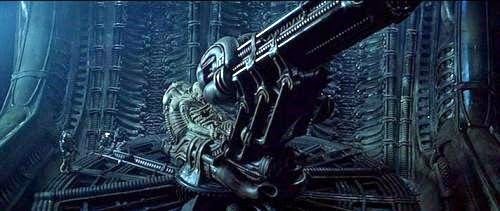
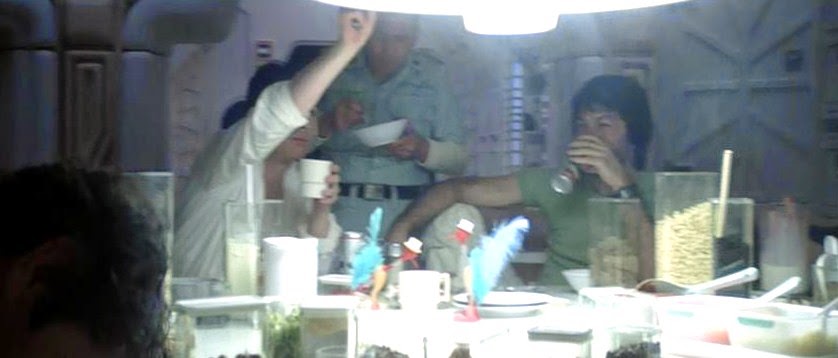
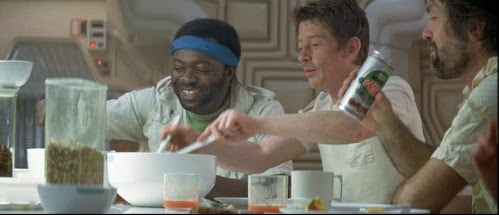
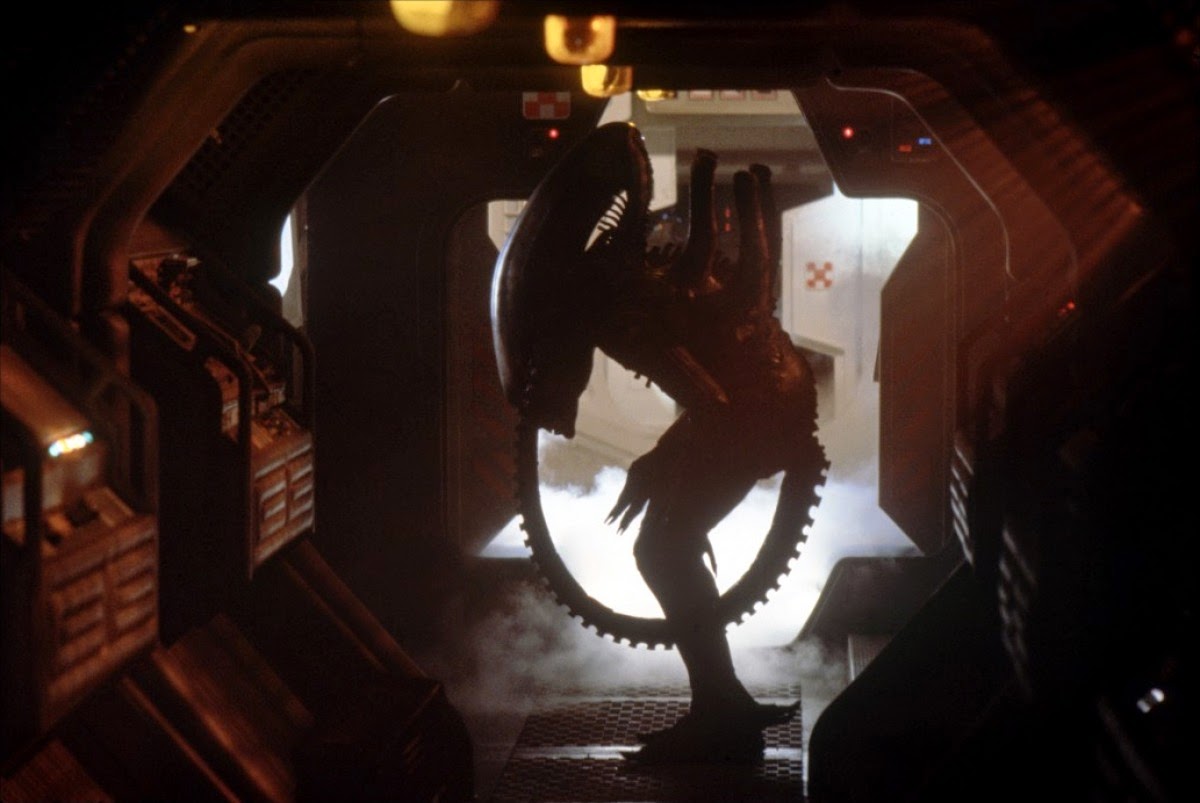




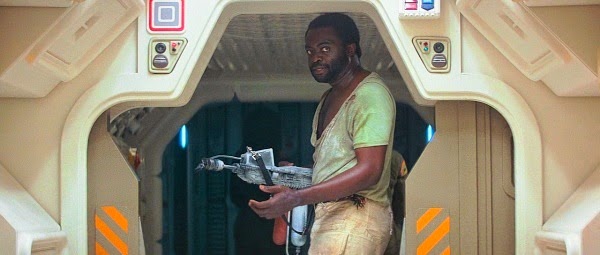








Your "read" on the film is very interesting but it seems like you neglected Dallas and Brett. I think you've covered Brett in a sense. He's a slacker but the opposite of Parker. I'm not certain how to pin down Brett's character given the sexual subtext you've proposed but the "slacker" attitude must have some importance. Perhaps, the Alien understands that Brett is easy prey, a fearful person who will not defend himself because he doesn't stand for anything but his own desire for leisure.
ReplyDeleteIt's Captain Dallas I'm most interested in. By all accounts, he seems to be a perfectly good captain. He leads the exploratory mission, he delegates responsibility properly and listens to his crew. Perhaps Dallas' weakness is that he's a stooge of his employer so he's a "kept" man dependent on the graces of Weyland_Yutani. That relationship is exemplified by his interactions and dependency with Mother, without whom he can't do anything.
At any rate, I'd love to know how these characters fit into your interpretation of the this classic film. Thanks as always for a very enjoyable article!
Pierre
Sexual imagery and repressed urges are evident here, but this all seems hyper-analyzed. The rolled up magazine, whether intended or not, can easily be interpreted as just a nasty way to kill someone. Also, Ash's white fluid may have been Ridley Scott finally granting a synthetic life form its first and last orgasm, but I've never thought of it that way. In fact, it's not necessary to even consider it to get meaning out of the story. James Cameron's next robot, "Bishop" in the sequel "Aliens" has milky fluid, too. Should I view Bishop's dismemberment by the queen alien and his subsequent spewing of the white fluid to be hinting at premature ejaculation before the queen and Ripley come to the climax of their conflict. I mean, you can interpret almost any and everything from these films.
ReplyDeleteLooking around my office, I can see many things from the hole in the center of a DVD to a pencil that if I wanted to be annoying, could symbolize penetration. In fact, I just plugged a very aggressive looking, cylindrical headphone jack into a ready and willing female connector on my PC. So using my headphones could be assessed as an alternate sexual encounter?